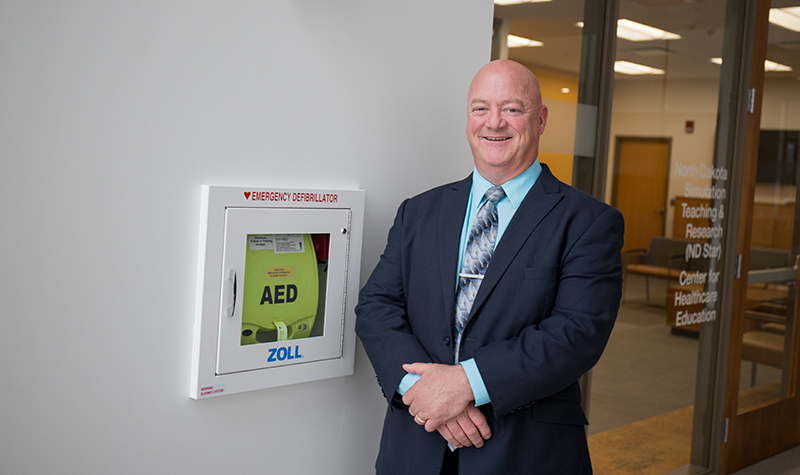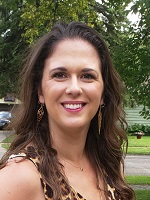13 Sep UND works to be designated a Cardiac Ready Campus

Terry Wynne, UND’s director of safety, stands next to an AED station on the first floor of the UND School of Medicine & Health Sciences. The University is making a push to receive designation as a Cardiac Ready Campus. Photo by Connor Murphy/UND Today.
When a person has a heart attack, every second counts.
“With every minute that passes, you lose 10 percent chance of survivability,” said Terry Wynne, UND director of safety. “You have to act as soon as you can.”
That’s one of the reasons UND is working to be the first university or college in the state – and perhaps the nation – to be named a Cardiac Ready Campus by the North Dakota Department of Health’s Division of Emergency Medical Services. UND is seeking the designation in partnership with the UND College of Nursing & Professional Disciplines, UND Work Well and Altru Health System.
The campaign kicked off earlier this spring, and organizers expect to submit the application to the North Dakota Department of Health soon.
Once UND is designated as a Cardiac Ready Campus, it will focus on four aspects of cardiac health and readiness: stroke, hypertension, heart attack and CPR/AED training.
Cardiac campaign
The campaign’s goals are to educate students, faculty and staff about the risks of heart disease, train them to perform CPR or use defibrillators and offer blood pressure screening.

Dr. Bryan Delage
One of the projects, a map of defibrillators on campus, is already complete.
“When we say Cardiac Ready Campus, it’s really a Cardiac Ready Community,” said Dr. Bryan Delage, assistant professor of family & community medicine at the UND School of Medicine & Health Sciences, who is spearheading the campaign. “If we promote it on campus, we may generate interest among students, who might promote Cardiac Ready Communities throughout the state. We want to get the message out about how we can improve outcomes.”
A number of people have suffered heart attacks on campus over the decades, Wynne said. But in recent years, thanks to quick action by University community members and defibrillators stationed across campus, more have survived.

Terry Wynne
“In one case, a department had talked about cardiac issues and emergencies at a meeting,” Wynne said. “Later, a staff member came into work, and his co-workers noticed something was wrong. He was in the middle of a heart attack. They acted quickly, and he had five stents put in. He would have died if people hadn’t acted quickly. That makes all the difference.”
“The outcomes from an acute cardiac arrest vary widely, with the average nationwide survival rate being only about 10 percent,” said Delage. “But in places where early CPR (cardiopulmonary resuscitation) or defibrillators were more likely to be available, the survival rate rose to 60 percent.
“That’s a 50 percent difference in survival rates – a huge difference. That’s what prompted me to promote UND as a Cardiac Ready Campus.”
Through education, training and community awareness, UND can improve the potential survival of such events in the campus community and Grand Forks, Delage said.
Know your numbers
“High blood pressure is a risk factor for heart attacks,” Delage said. “If you’re in your doctor’s office and they say your blood pressure is a bit high, we want to raise awareness.”

Tiffany Knauf
“About 33 percent of North Dakotans have high blood pressure,” said Tiffany Knauf, Hypertension and Health Systems Coordinator with the North Dakota Department of Health, who is working with UND to help it earn the designation.
“The best way to avoid a stroke or heart attack is to get your blood pressure under control. If we can bring awareness to campus about the importance of getting your blood pressure under control so you can avoid emergencies, or more effectively save someone quickly in case of an emergency, it can make a huge impact.”
Increasing survival
Early CPR is also important, Delage added.
“Good CPR, initiated early, can really increase survival,” said Delage. “Initiating it early and maintaining it extends how likely people are to be resuscitated. That’s why all the efforts we’ve chosen improve that chance of survival.
“Teaching people to start and do effective CPR, and to get a defibrillator on as early as possible and then getting EMS there are all part of the chain of survival that the American Heart Association talks about.”
Changing best practice CPR to compressions from mouth-to-mouth has also improved survival rates, Delage said.
“Laypeople are more likely to do chest compressions,” Delage said. “If you can get compressions going and get emergency medical services there within 10 minutes, data shows there is no difference in save rates between a health care provider doing mouth-to-mouth breathing versus compressions only. People are more willing to do chest compressions, and that increases the save rate.”
Delage said that some communities in North Dakota are already cardiac aware, but he would like to expand that awareness throughout the state.
“Our hope is that medical students will help promote the effort while doing their family medicine rotation, or when they go home for the summer,” Delage said. “We want to generate interest among students who could promote a Cardiac Ready Community once they’ve seen it on campus. We hope this propagates through the state of North Dakota.”



